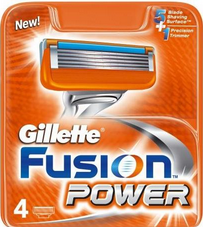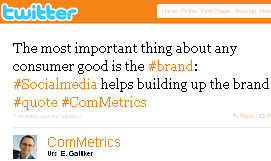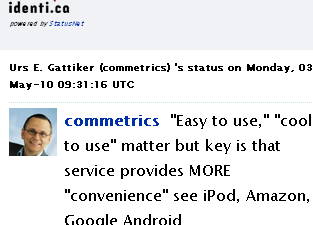We have mentioned the Oracle of Omaha before:
- ComMetrics: If it is good enough for Warren Buffett, what about you?
ComMetrics: Warren Buffet – ropes to skip – c-level blogs – FAQ #2
Warren Buffett’s beloved Gillette sells cheap razors that require pricey blades. These days it looks like Apple has found a way to reverse this model.
With the proliferation of low-cost apps for every niche interest, users are increasingly drawn and bound to Apple, prompting them to buy the expensive hardware. In turn, Apple enjoys operating margins of 29 percent, the envy of fellow phone and computer makers.
Nokia’s average smartphone costs €155 (by the way, Nokia’s last smartphone hit was the N95, launched in 2006). However, Apple manages to charge an average price of about €450 for its iPhone.
To see how social media figures into such products, we need to address some important questions:
- a) can Gillette’s razor and razor-blade model, or a slightly modified version be applied to any product?
b) can social media help reach more clients and keep them engaged?
c) does Apple’s increasing binds between users and its products and services work for others?
Customer experience: Managing the life-cycle challenge
Whatever the product, every user or client passes through the customer experience life-cycle model below.
- 1. Realization – Recognition of a potential customer’s problem or need.
2. Awareness – Connection between need and your product (e.g., being referred to our blog by search engine results).
3. Evaluation – Consideration of your (and your competitors’) product benefits and trade-offs as a solution.
4. Transaction – Customer places order or purchases the product/service.
5. Usage – Product is consumed or used (e.g., capital products – computer hardware used at the company).
6. Service – Post-purchase support (e.g., user community, special client events) for your product.
Of course, selling a product online (e.g., books) versus using the web to support offline activities (e.g., the neighborhood bookstore) makes a difference in how the above plays out.
Moreover, selling house facades, doors and castings for high-rises is a different kettle of fish than trying to get people to purchase your overpriced cup of coffee.
The facade manufacturer might first be invited to submit a tender for the building. If the tenderer is chosen, negotiations start between architects, a general contractor and the facade manufacturer. During these negotiations, final details and pricing are worked out before the purchase or transaction can go forward. In fact, it may still end in stillbirth. Sometimes one can win a tender or design competition but the final contract lands with the second or third competitor.
In contrast, if I want to purchase the latest book by a famous author, I may search for the book or go to my favorite online bookstore. Once found, I enter my credit card details and push the button to get the book delivered to my home within a few days. Vastly less complex than the selling of a house facade.
- Answer to question A: The Gillette razor and razor-blade model may not apply to those trying to sell power plants, capital goods or professional services. As well, organizations without a respectable advertising budget may not try the razor blade model.
Can social media help improve revenues
 Facebook likes to mention Adidas as an example for how much social media can improve your bottom line.
Facebook likes to mention Adidas as an example for how much social media can improve your bottom line.
Adidas has about 2.7 million fans on its Adidas Originals page. Each fan is estimated to be worth around $100 a year in footwear, making its fan page a community worth more than $200 million.
Facebook claims that Adidas’ advantage is that, for just the cost of maintaining the page, it can communicate directly with these people all year.
In some instances it is obvious that the chance to get another discount coupon or ticket to a VIP event is all it takes to get some people to follow (e.g., After a sour start in social media, Skittles gets sweet results). The above is nothing more than duplicating the Sunday newspaper’s coupon section. For instance, Gillette offers a $2 coupon off its pricey blades that the consumer can clip out of the Sunday paper and use the next time he goes to his favorite store to buy replacement blades.
Here social media can help increase the brand’s reach by also distributing these coupons to Facebook fans or Twitter followers. And since some of these people might not get a Sunday newspaper… How loyal such fans might be is another question. Plus, having its own community while providing relevant content via a corporate blog may be more effective for Adidas to improve engagement levels.
- Answer to question B: Using advertising budgets to increase Facebook fans or Twitter followers does not automatically build brand loyalty or improve engagement.
Convenience
 It is obvious given the many devices we have, from computers to smartphones to MP3 players to home stereo, convenience comes into play. For instance, copying your playlist from one device to the next can be a cumbersome experience. iTunes remains a success in part because it allows people to synchronize their music across Apple and Windows devices.
It is obvious given the many devices we have, from computers to smartphones to MP3 players to home stereo, convenience comes into play. For instance, copying your playlist from one device to the next can be a cumbersome experience. iTunes remains a success in part because it allows people to synchronize their music across Apple and Windows devices.
Spotify tries to modify this approach and its 7 million European users suggests it is doing something right by offering access to its library of millions of tracks over the internet. It is now trying to compete with Apple by offering technology that allows absorbing a user’s existing digital music collection within the same interface, and synchronizing it with mobile devices that run its app, such as Apple’s own iPhone. For the first time, the new software will allow Spotify users to dispense completely with iTunes.
For consumer products convenience is a factor, but if you need to decide which house facade might be best on your 30 story building, many different things come into play. For starters, the price paid to install the facade, as well as its carbon footprint. Maintenance costs, including cleaning and upkeep, also play an important role.
- Answer to question C: Apple demonstrates that consumers are willing to pay for convenience while being able to increasing bind their customers to its products. However, convenience may play a minor role with capital goods. For the latter, upfront price, including life-time costs or savings, is critical.
Take-aways
- 1. What works for Apple or Gillette could fail miserably for you, especially if you offer professional services, try to sell capital goods (e.g., build oil platforms) or want to raise money as a charity.
- 2. Focus on today’s sure thing rather than on the next big thing. Even if Facebook fans offer spectacular revenue potential, no one can predict how much revenue this will generate over the next decade. Having 10,000 subscribers paying €200 every year for web-based software as a service makes more sense than hunting for another 10,000 Facebook fans.
- 3. If engagement is critical, use social media accordingly. Freebies and discount coupons always attract attention from certain groups of consumers. But to improve engagement with business clients one must consider that industrial buyers look for different things in a Twitter account to follow or reading and commenting on a blog.
More resources
- ComMetrics – Ueberzeugungs-Marketing – warum der Kunde bei Procter & Gamble, Gillette nicht immer der Boss ist
ComMetrics – 2010 trends: Data and mobile communication
Warren Buffett – BERKSHIRE HATHAWAY INC. – shareholder letters
What is your take? How do you see these issues? Have you tried to apply any of these approaches for your products? Worked, failed – share, please! Please let us know in the comments!
You can get updates for this blog on Twitter by following @ComMetrics, get a free subscription by RSS, or get new posts via email:
Article source: ComMetrics – Warren Buffett: What works with social media
This blog post is related to our webinar held on 2010-05-05 – Warren Buffett says: Social media can work for you
Attend our webinars by registering for ComMetrics University – we help you improve your social media performance faster
Pingback: S Johnson-Wozowiecki
Pingback: TBO interactive
Pingback: Belinda Ang
Pingback: Vincent Teo
Pingback: Jolt Social Media
Pingback: Naijand Inc
Pingback: Ellie Fitzgerld
Pingback: Joel Mackey
Pingback: Joseph Cannizzaro
Pingback: Lori Taylor